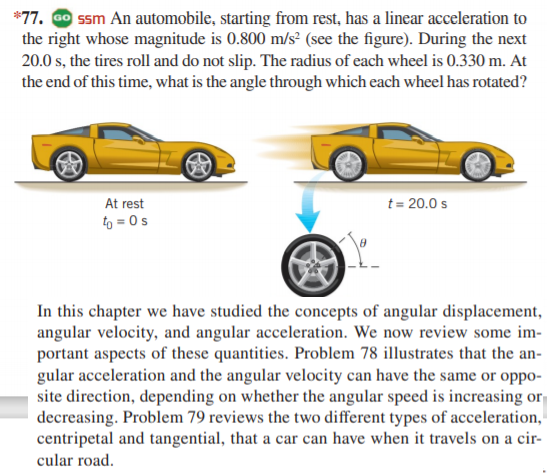*77. Go ssm An automobile, starting from rest, has a linear acceleration to the right whose magnitude is 0.800 m/s² (see the figure). During the next 20.0 s, the tires roll and do not slip. The radius of each wheel is 0.330 m. At the end of this time, what is the angle through which each wheel has rotated? At rest t= 20.0 s to = 0s In this chapter we have studied the concepts of angular displacement, angular velocity, and angular acceleration. We now review some im- portant aspects of these quantities. Problem 78 illustrates that the an- gular acceleration and the angular velocity can have the same or oppo- site direction, depending on whether the angular speed is increasing or decreasing. Problem 79 reviews the two different types of acceleration, centripetal and tangential, that a car can have when it travels on a cir- cular road.
*77. Go ssm An automobile, starting from rest, has a linear acceleration to the right whose magnitude is 0.800 m/s² (see the figure). During the next 20.0 s, the tires roll and do not slip. The radius of each wheel is 0.330 m. At the end of this time, what is the angle through which each wheel has rotated? At rest t= 20.0 s to = 0s In this chapter we have studied the concepts of angular displacement, angular velocity, and angular acceleration. We now review some im- portant aspects of these quantities. Problem 78 illustrates that the an- gular acceleration and the angular velocity can have the same or oppo- site direction, depending on whether the angular speed is increasing or decreasing. Problem 79 reviews the two different types of acceleration, centripetal and tangential, that a car can have when it travels on a cir- cular road.
Physics for Scientists and Engineers: Foundations and Connections
1st Edition
ISBN:9781133939146
Author:Katz, Debora M.
Publisher:Katz, Debora M.
Chapter12: Rotation I: Kinematics And Dynamics
Section: Chapter Questions
Problem 77PQ
Related questions
Question

Transcribed Image Text:*77. Go ssm An automobile, starting from rest, has a linear acceleration to
the right whose magnitude is 0.800 m/s² (see the figure). During the next
20.0 s, the tires roll and do not slip. The radius of each wheel is 0.330 m. At
the end of this time, what is the angle through which each wheel has rotated?
At rest
t= 20.0 s
to = 0s
In this chapter we have studied the concepts of angular displacement,
angular velocity, and angular acceleration. We now review some im-
portant aspects of these quantities. Problem 78 illustrates that the an-
gular acceleration and the angular velocity can have the same or oppo-
site direction, depending on whether the angular speed is increasing or
decreasing. Problem 79 reviews the two different types of acceleration,
centripetal and tangential, that a car can have when it travels on a cir-
cular road.
Expert Solution
This question has been solved!
Explore an expertly crafted, step-by-step solution for a thorough understanding of key concepts.
This is a popular solution!
Trending now
This is a popular solution!
Step by step
Solved in 3 steps with 3 images

Recommended textbooks for you

Physics for Scientists and Engineers: Foundations…
Physics
ISBN:
9781133939146
Author:
Katz, Debora M.
Publisher:
Cengage Learning

College Physics
Physics
ISBN:
9781305952300
Author:
Raymond A. Serway, Chris Vuille
Publisher:
Cengage Learning

Principles of Physics: A Calculus-Based Text
Physics
ISBN:
9781133104261
Author:
Raymond A. Serway, John W. Jewett
Publisher:
Cengage Learning

Physics for Scientists and Engineers: Foundations…
Physics
ISBN:
9781133939146
Author:
Katz, Debora M.
Publisher:
Cengage Learning

College Physics
Physics
ISBN:
9781305952300
Author:
Raymond A. Serway, Chris Vuille
Publisher:
Cengage Learning

Principles of Physics: A Calculus-Based Text
Physics
ISBN:
9781133104261
Author:
Raymond A. Serway, John W. Jewett
Publisher:
Cengage Learning